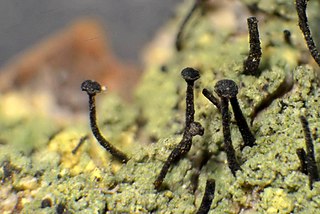
The Physciaceae are a family of mostly lichen-forming fungi belonging to the class Lecanoromycetes in the division Ascomycota. A 2016 estimate placed 19 genera and 601 species in the family.
Cratiria is a genus of lichen-forming fungi in the family Caliciaceae. The genus has a widespread distribution, especially in tropical regions, and contains about 20 species. The genus was circumscribed by Austrian lichenologist Bernhard Marbach in 2000, with Cratiria lauri-cassiae assigned as the type species.

Amandinea is a genus of lichenized fungi in the family Caliciaceae. Genetic studies indicates that the genus Amandinea and Buellia are the same, although this is not widely accepted.

Hafellia is a genus of lichen-forming fungi in the family Caliciaceae. The genus has a widespread distribution, especially in tropical regions. The genus is named in honour of the Austrian lichenologist Josef Hafellner. The genus was proposed by the German lichenologist Klaus Kalb in 1986 to contain two bark-dwelling species, formerly in genus Buellia, with callispora-type spores. These ascospores have ridged walls, and are thin walled at their tips at early states of their differentiation.

Gassicurtia is a genus of lichenized fungi in the family Caliciaceae.

The Caliciaceae are a family of mostly lichen-forming fungi belonging to the class Lecanoromycetes in the division Ascomycota. Although the family has had its classification changed several times throughout its taxonomic history, the use of modern molecular phylogenetic methods have helped to establish its current placement in the order Caliciales. Caliciaceae contains 39 genera and about 670 species. The largest genus is Buellia, with around 300 species; there are more than a dozen genera that contain only a single species.
Baculifera is a genus of lichens in the family Caliciaceae. It was circumscribed in 2000 by Bernhard Marbach and Klaus Kalb. Species in this genus are characterized by having bacilliform conidia typically measuring 8–11 μm long, and a non-inspersed hymenium. The genus is roughly similar in morphology to Buellia.
Endohyalina is a genus of 10 species of corticolous lichens in the family Caliciaceae. The genus was circumscribed by Bernhard Marbach in 2000, with Endohyalina rappii designated as the type species.
Chrismofulvea is a genus of lichen-forming fungi in the family Caliciaceae. The genus was circumscribed by Austrian lichenologist Bernhard Marbach in 2000, with Chrismofulvea dialyta assigned as the type species. It was one of several segregate genera proposed by Marbach in his 2000 revision of American species of Buellia.
Fluctua is a lichen genus in the family Caliciaceae. It is monotypic, containing the single crustose lichen species Fluctua megapotamica. The genus was circumscribed by Austrian lichenologist Bernhard Marbach in 2000. It was one of several segregate genera proposed by Marbach in his 2000 revision of American species of Buellia. The lichen is found in Brazil and Uruguay.
Buellia magaliesbergensis is a species of crustose lichen in the family Caliciaceae. Found in South Africa, it was formally described as a new species in 2021 by lichenologists John Alan Elix and Helmut Mayrhofer. The type specimen was collected in the Magaliesberg Range at an altitude of 1,720 m (5,640 ft). Here, the saxicolous lichen was found growing on rocks on the ground. The species epithet refers to the type locality, the only location where the lichen has been documented. The results of standard chemical spot tests are thallus K+ (yellow), P+ (yellow-orange), and C−. Buellia magaliesbergensis contains norstictic acid as a major secondary chemical and connorstictic acid as a minor compound.
Buellia subeffigurata is a species of crustose lichen in the family Caliciaceae. Found in South Africa, it was formally described as a new species in 2021 by John Alan Elix, Helmut Mayrhofer, and Wolfgang Wetschnig. The type specimen was collected in the Knersvlakte, at an altitude of 150 m (490 ft). Here the saxicolous lichen was found growing on quartziferous rock. The species epithet refers to its subeffigurate marginal lobes. The results of standard chemical spot tests are: thallus K+ (yellow), P+ (yellow-orange), and C−. Buellia subeffigurata contains thiophanic acid as a major secondary chemical, and isoarthothelin and atranorin as minor compounds.
Brownliella is a genus of crustose lichens in the subfamily Teloschistoideae of the family Teloschistaceae. It has two species. The genus was circumscribed in 2013 by Sergey Kondratyuk, Ingvar Kärnefelt, John Elix, Arne Thell, and Jae-Seoun Hur, with the widely distributed lichen Brownliella aequata assigned as the type species. The genus contains species formerly referred to as the Caloplaca cinnabarina species group. The generic name honours Australian botanist Sue Brownlie.
Buellia capensis is a species of crustose lichen in the family Caliciaceae. Found in South Africa, it was formally described as new species in 2021 by John Elix and Helmut Mayrhofer. The type specimen was collected south of Langebaan at an altitude ranging from 80 to 130 m ; here it was found growing on granite from a south-exposed slope. It is only known from the type collection. The contains several secondary compounds, including lichexanthone and secalonic acid A as major metabolites, and trace amounts of fumarprotocetraric acid and succinprotocetraric acid. The specific epithet capensis refers to the region of the type locality.
Kaernefia is a genus of crustose lichens in the family Teloschistaceae. It has three species, found in Australia or South Africa.
Huneckia is a genus of crustose lichens in the subfamily Caloplacoideae of the family Teloschistaceae. It has four species.

Ciposia is a single-species fungal genus in the family Caliciaceae. Circumscribed by Bernhard Marbach in 2000, it contains the species Ciposia wheeleri, a corticolous (bark-dwelling) and crustose lichen. This species was originally classified in genus Buellia by Richard Harris in 1988.
Marchantiana is a genus of lichen-forming fungi in the family Teloschistaceae. It contains seven species of corticolous (bark-dwelling), crustose lichens that occur in the Southern Hemisphere.
Eilifdahlia is a genus of lichen-forming fungi in the family Teloschistaceae. It contains three species of corticolous (bark-dwelling), crustose lichens that occur in the Southern Hemisphere.





